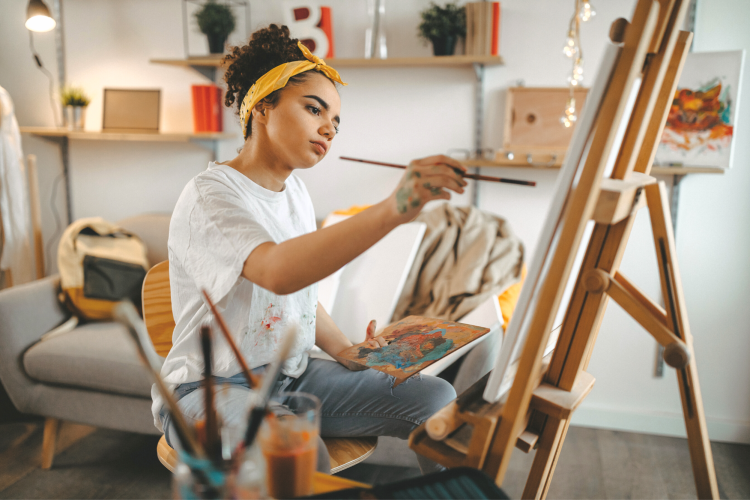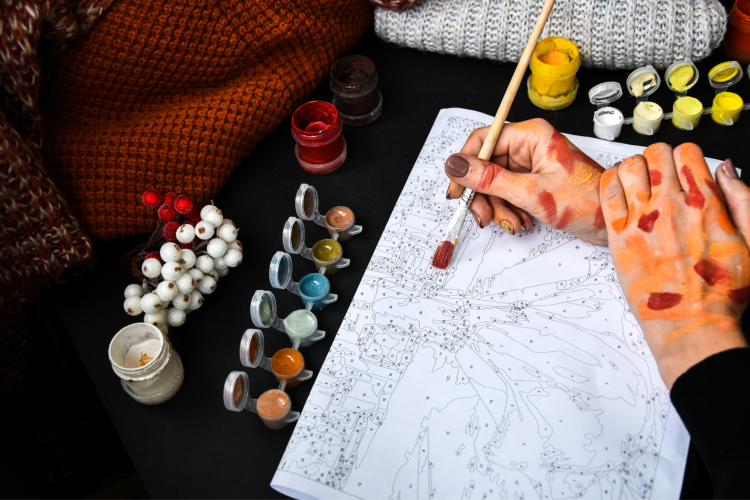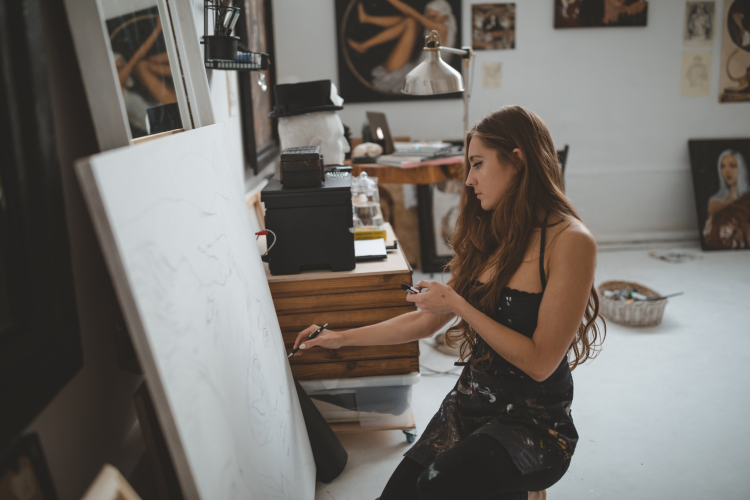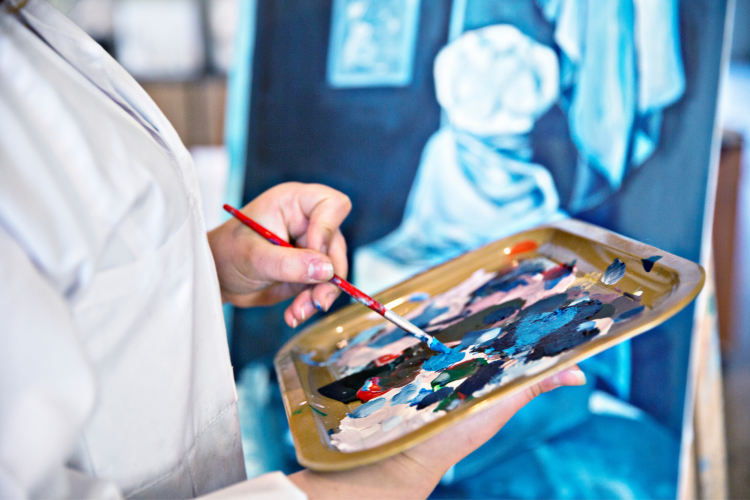31 Best Acrylic Painting Tips for Beginners

Are you looking for helpful painting tips for beginners so you can start learning how to paint with acrylics and start your life as an artist? Getting started is the hardest part. Many artists start with acrylics, but is acrylic painting easy for beginners? It can be, but there’s still a learning process involved!
According to the Journal of American Art Therapy Association, creating art can lower your cortisol levels, so being an artist is about more than just creating beautiful pieces of artwork! It can calm you down as well. With that in mind, let's talk about a few helpful acrylic painting tips for beginners so you can start your soothing creativity journey. And be sure to check out our article on how to get acrylic paint out of clothes if you've made a little mess.
Jump to Section
- Tips for Getting Started
- Tips for Painting on Canvas
- Tips for Making Brushstrokes
- Tips for Blending Paint
Tips for Getting Started
1. Make It Fun With Paint and Sip
Paint and sip is a great option for new painters. While people of all skill levels enjoy paint and sip classes, they offer plenty of painting tips for beginners. If wine isn't your thing, you can bring your own beverage, no alcohol necessary. Explore paint and sip in Sacramento, paint and sip in Chicago, paint and sip in Los Angeles, or paint and sip near you!

2. Online Painting Classes
If you prefer learning from the comfort of home, consider taking online painting classes so you can start with a good foundation. An experienced instructor will walk you through the first steps toward becoming a fantastic painter. They offer plenty of useful painting tips for beginners.
3. Follow Artists Online
The internet is your best resource for finding inspiring acrylic painting ideas for beginners. Find artists on social media who inspire you and give them a follow! Try to understand what they’re doing and identify exactly what it is about their work that you like so you can take inspiration from it.
Many popular artists also post helpful painting tips for beginners who follow them. They may also share their own unusual acrylic painting techniques.
4. Watch and Read Tutorials
Again, the internet is a great resource. There are thousands of online tutorials for every step of your painting process, no matter how niche. Whether you’re trying to figure out how to paint realistic fur or you just can’t figure out how to blend the right shade of pink, there’s a tutorial for you.
Some artists even specialize in making content about painting tips for beginners.
5. Buy the Right Paint
One of the top painting tips for beginners is to buy the right paint. You may be tempted to pick up the most affordable paint (craft paint), but this isn’t a good move. It’s far less opaque and harder to work with.
Choose at least student-quality paint to start. Make sure you buy (at least) all of the primary colors, alongside black and white.

6. Choose Your Brushes Carefully
Your brushes matter, too! You want brushes that are semi-firm and you want a variety of sizes. Brushes that are too soft work better with watercolor, and while you may end up using them for acrylics in the future, it’s best to wait until you have more experience.
7. Pick the Right Painting Surfaces
Acrylic paint is incredibly versatile, so where will you use it?
Most people start on canvas or thick paper. Avoid any paper that’s too thin or it will buckle with the weight of the paint. You can also paint on primed wood, ceramic or even your walls (but then you may need to learn some house painting tips for beginners!).
As a beginner, it’s a good idea to try a variety of surfaces until you find one that works for you.
8. Don’t Be Afraid of Mistakes
A blank canvas might look like a mistake ready to happen, but don’t let that stop you from painting! Mistakes happen, and fixing them is a breeze. When you let yourself make mistakes, you give yourself the opportunity to learn new and unusual acrylic painting techniques.
If you’re wondering “How do I get better at painting with acrylics?”, the answer is that you have to start somewhere and, more importantly, keep trying. This is a helpful painting tip for beginners who are too afraid to get started.
9. Try a Paint-by-Numbers Canvas
How do you paint with acrylics for beginners if you’re not a good artist to start with? You don’t have to be. Everyone starts somewhere, and even if you’re not drawing well, you can still paint.
Starting with adult paint-by-numbers canvases is a great painting tip for beginners. They tell you exactly where to apply color so you can learn the basics even before you’re able to construct your own paintings. They’re like artist training wheels.

10. Store Brushes With Bristles Pointing Up
This painting tip for beginners has to do with your brushes. When you finish a hard day of painting and you've learned how to clean your paintbrushes properly, be careful how you store them!
If you leave the bristles pointing down, you’ll end up misshaping them. It’s difficult to use them to make neat strokes after that happens. This is true for both soft and firm brushes.
11. Always Gather Supplies First
One of the top five tips for acrylic painting that we can offer is to make sure you gather all of your supplies before you start working. Double-check before you even start mixing paint.
Pro painting tip for beginners: Acrylic paint dries quickly, so you only have a limited amount of time to work with after you put the paint on your palette. If you waste that time rushing to get something you’ve forgotten, you will waste paint.
12. Don’t Compare Yourself to Others
One of the best painting tips for beginners is to avoid comparing yourself to other artists. We all learn at different paces, and you can’t expect yourself to be a pro when you first get started. Painting is more difficult than it looks. Comparison is the thief of joy. Focus on your own progress.
13. Paint With Peers
Learning is more fun with friends. Get together with other artists in your friend group and have a paint night. So, why is this one of the top painting tips for beginners?
When you’re painting with others, you have the opportunity to help each other and share acrylic painting techniques. You can also give each other helpful constructive criticism.
Consider turning painting sessions into a routine get-together. This will also give you more motivation to practice than if you were only painting alone.

Tips for Painting on Canvas
14. Prime Your Canvas
When you buy a canvas, it will either be primed or unprimed. If it’s not primed, make sure that you use primer (like gesso) before you start painting. You only need a thin coat.
This gives you a smooth surface to work with and gives the paint something to adhere to. If you struggle with the bumpy texture of your canvas, adding an extra layer of primer won’t hurt. Beginners often prefer a smooth surface.
Bonus tip: priming is also one of the best house painting tips for beginners! You always want to start with a good foundation.
15. Create a Comfortable Set-Up
One of the best painting tips for beginners is to paint how you’re comfortable. For some people, this means setting up an easel and stool. For others, this may mean painting with the canvas on the floor or propped up against the wall.
You’ll be painting for a while and it’s generally best to keep the canvas in the same general position throughout the painting process. Try a few different positions to see what works for you! Don’t skip this helpful tip for acrylic painting on canvas.
16. Learn How to “Erase” Mistakes
A helpful painting tip for your beginner painting ideas is that you can “erase” mistakes. If the mistake is fresh, you can get rid of it with a bit of water on a firm brush. You can then paint over it with white paint.
On a dry canvas, either paint over the mistake with white or use sandpaper to gently file it away.
17. Sketch or Underpaint
You don’t have to start making your masterpiece right away. Start with a sketch or underpainting. An underpainting is like a loose sketch you make with watered-down paint.
This will give you a great starting point! Quick painting tip for beginners: make sure your sketch is light enough that you can easily paint over it.

18. Keep Your Canvas Wedges
When you buy a canvas, you might get a small bag full of small wood pieces. Keep those! One of the top tips for acrylic painting on canvas is to use those canvas wedges if your painting starts to “dip” in the center. When you place the wedges in the corners of your canvas, it should pull it taught again.
19. Store Your Painting Carefully
We can’t talk about painting tips for beginners without discussing how to store your work. Unlike oil paintings, you do not have to varnish acrylics. Instead, just store them carefully.
If you don’t want to hang your paintings, store them vertically somewhere dark, cool, and dry. Avoid stacking anything on top. Remember, canvas is fabric and it can rip or bend.
Tips for Making Brushstrokes
20. Pick the Right Size and Shape of Brush
Brushes come in all shapes and sizes. One of our top five tips for acrylic painting is to choose a brush that’s suited for your purpose.
If you were trying to paint a thick background layer, you’d want a wide and flat brush. That wide and flat brush wouldn’t work if you were trying to paint fine lines. You’d want a thin and pointed brush.
One of our top painting tips for beginners is to try a variety of brushes on scrap paper before beginning.
21. Use Plenty of Paint on the Brush
If you want to make nice and smooth brushstrokes, you want to have plenty of paint on the brush. Don’t worry about wasting it. If the brush is too dry, the resulting brush stroke will look feathery and rough.

22. Don’t Be Afraid to Be Bold
Quick painting tip for beginners: be bold with your strokes. Hesitant strokes look weak. Bold strokes look intentional and smooth. Remember one of our previous painting tips for beginners: you can always “erase” if you mess up.
23. Practice a Variety of Unique Strokes
Don’t get into the habit of using the same stroke for every painting. While you’re looking up painting tips for beginners, you should also be looking up a variety of brushstrokes. Mix and match your strokes. Practice them on paper or a scrap piece of canvas.
24. Study Your Subject to Choose a Stroke
Again, there are different strokes for different purposes! An important painting tip for beginners is to play close attention to your subject to figure out what stroke would work best.
For example, would you use the same stroke for soft fur as you would for a flower petal? Observe the sizes and shapes of the things you’ree painting and try to match your strokes.
25. Try Wetting Your Brush First
Here’s a helpful painting tip for beginners. You might be wondering “Do you wet the brush before using acrylic paint?” You can! If you dampen the brush first, you’ll end up with smoother brushstrokes and slightly sheerer paint. You can keep your brush dry, but your strokes won’t be as smooth. Try both methods!

Tips for Blending Paint
26. Leave Some Strokes Unblended
There are so many acrylic painting tips for beginners for blending, but did you know you don’t actually have to blend? Layering or stacking paint is another effective method of using color.
If something isn’t blending the way you want it to, try placing colors alongside each other instead. It may look messy at first, but it will come together if you stick with it.
27. Don’t Mix Too Much Paint
As we mentioned in one of our earlier painting tips for beginners, acrylic paint dries quickly! When you mix too much paint, you’re just wasting it. However, if you insist on mixing a lot of paint to get enough of a specific color, you can use a sealable container to keep it wet for longer.
28. Work Quickly
One of our top painting tips for beginner acrylic artists is to work as quickly as you can without compromising your art.
When you paint with oil, you have plenty of time to get things just right. When you paint with acrylics, you have seconds before each stroke dries. If you plan on blending your colors, you need to do so almost instantly.
29. Use an Acrylic Medium
You can increase the drying time if you use an acrylic paint medium. This is one of the lesser-known painting tips for beginners. These mediums are called “retarding mediums” and you can find them at any art supply store. They will give you more time to blend your colors before they dry up.
30. Mist Your Paint With Water
This is a quick and easy painting tip for beginner artists! When you’re using acrylics, mist the canvas and your paint with water as you go.
This won’t be as effective as using the acrylic medium, but it’s easy and you don’t have to buy anything extra. Make sure you only add a small amount of water so you don’t dilute the colors.
31. Practice Blending Colors
Before you try blending on your canvas, practice blending colors on your palette and on scrap paper. This is one of the most basic painting tips for beginners. Start by learning how to make brown paint or how to make red paint.
Colors don’t always blend the way you think they will. Practice with affordable paints so you don’t end up with an undesirable color on your final painting!

So, which of these helpful painting tips for beginners will you try first? Try out these acrylic painting tips for beginners for blending, brushstrokes, painting on canvas and just getting started when you work on your next masterpiece!
For even more fun painting ideas, check out other experiences happening on Classpop!

